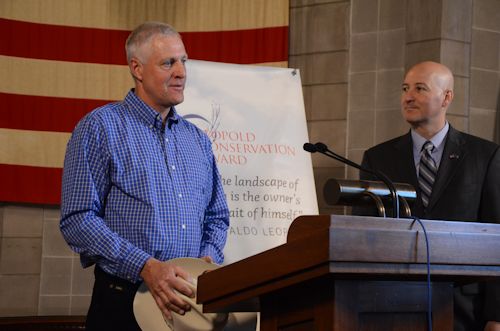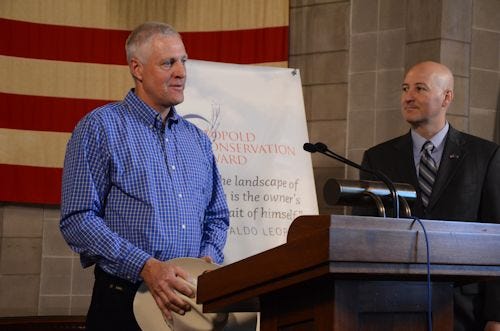
This week is a big one for conservationists. Not only is today Earth Day, but Friday marks a U.S. holiday 143 years old – Arbor Day. Back in 1872, Nebraska was still a young state. That year – just five years after Nebraska was admitted to the Union, and 13 years after Nebraska Farmer was first published – J. Sterling Morton, who had served as Secretary of the Nebraska Territory and Governor of Nebraska, founded Arbor Day in Nebraska City.

ROOTED IN CONSERVATION: Steve Shaw and Nebraska Governor Pete Ricketts last week during the announcement of Shaw Family Farms as the 10th recipient of the Nebraska Leopold Conservation Award. The Shaws graze cattle on wetlands while maintaining the vital habitat for the over 8.6 million waterfowl and 300,000 shorebirds that use these wetlands as a food resource and nesting ground.
As was pointed out last week at Nebraska State Capitol when Governor Pete Ricketts announced the Shaw family as the recipients of the 10th Nebraska Leopold Conservation Award, farmers and ranchers in Nebraska are the original conservationists. The award's namesake, Aldo Leopold, may have been born in Iowa and known best for his work at the University of Wisconsin-Madison, but it's clear the seeds of conservation are sprouted and growing in Nebraska as well.
That's not to say there isn't always plenty of room for improvement, but it's easy to get excited about the things farmers and ranchers are doing, demonstrating that production agriculture and environmental stewardship can be, and often are, complementary.
Take for example this year's Leopold Conservation Award recipients, Shaw Family Farms, a fifth generation row-crop and cattle operation in the Rainwater Basin of south-central Nebraska owned and managed by Steve and Vicki Shaw, and their son and daughter-in-law Brian and Julie Shaw. The Shaws graze cattle on wetlands, using an under-utilized grazing resource while maintaining a vital habitat for the over 8.6 million waterfowl and 300,000 shorebirds that use these wetlands as a food resource and nesting ground.
Of course, stewardship isn't limited to beef producers. Just look at efforts made by countless farmers to protect the soil from wind erosion with shelter belts, protect soil from water and wind erosion and improve water infiltration through no-till farming practices and planting cover crops, and efforts to reduce nitrates going into surface and groundwater using an array of management practices, including cover crops, filter strips, bioreactors, variable-rate and split applications of nitrogen.
Sustainability is a buzzword that gets thrown around a lot these days. But, as 2012 Nebraska Leopold Conservation Award recipient and fourth-generation Sandhills rancher Homer Buell pointed out last week, farmers and ranchers often see it in their best interest to be economically, socially, and environmentally, , sustainable, making the most efficient use of resources and ensuring the operation can thrive for a fifth, sixth, and seventh generation.
About the Author(s)
You May Also Like






